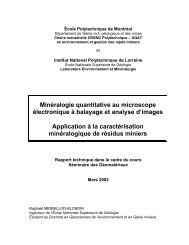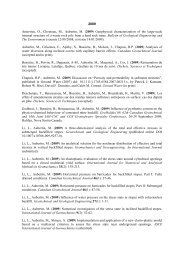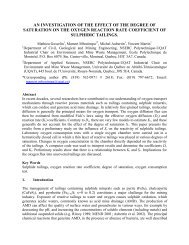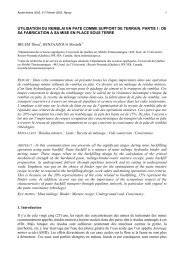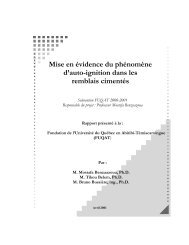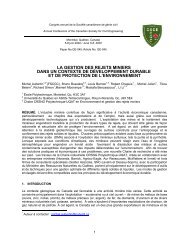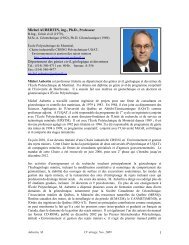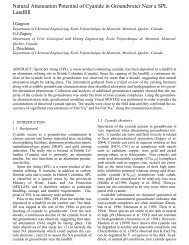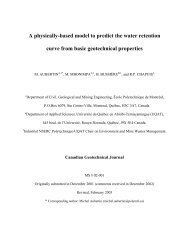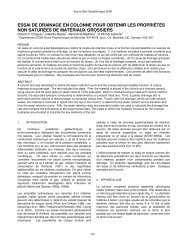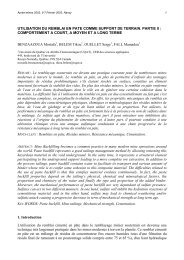passive treatment of acid mine drainage in bioreactors - Ãcole ...
passive treatment of acid mine drainage in bioreactors - Ãcole ...
passive treatment of acid mine drainage in bioreactors - Ãcole ...
You also want an ePaper? Increase the reach of your titles
YUMPU automatically turns print PDFs into web optimized ePapers that Google loves.
OttawaGeo2007/OttawaGéo2007<br />
PASSIVE TREATMENT OF ACID MINE DRAINAGE IN<br />
BIOREACTORS: SHORT REVIEW, APPLICATIONS,<br />
AND RESEARCH NEEDS<br />
G.J. Zagury and C. Neculita<br />
Department <strong>of</strong> Civil, Geological, and M<strong>in</strong><strong>in</strong>g Eng<strong>in</strong>eer<strong>in</strong>g - École Polytechnique<br />
de Montréal, Montreal, QC, Canada<br />
B. Bussière<br />
Department <strong>of</strong> Applied Sciences - Université du Québec en Abitibi-<br />
Témiscam<strong>in</strong>gue, Rouyn-Noranda, QC, Canada & NSERC Polytechnique/UQAT<br />
Industrial Chair <strong>in</strong> Environment and M<strong>in</strong>e Waste Management and Canada<br />
Research Chair on Abandoned M<strong>in</strong>e Site Rehabilitation<br />
ABSTRACT<br />
Sulphate-reduc<strong>in</strong>g <strong>passive</strong> <strong>bioreactors</strong> have received much attention lately as alternat<strong>in</strong>g technologies for <strong>acid</strong> <strong>m<strong>in</strong>e</strong><br />
<strong>dra<strong>in</strong>age</strong> (AMD) <strong>treatment</strong>. The long-term efficiency is sometimes limited because they rely on the activity <strong>of</strong> sulphatereduc<strong>in</strong>g<br />
bacteria (SRB) which is primarily controlled by the reactive mixture composition. Our review shows that the<br />
most important mixture component is the organic carbon source. Several studies conducted to f<strong>in</strong>d the best mixture <strong>of</strong><br />
natural organic substrates for SRB showed that a comb<strong>in</strong>ation <strong>of</strong> organic carbon sources is preferable than a unique<br />
source. In addition to metal sulphide precipitation, which is the ma<strong>in</strong> metal removal mechanism, other mechanisms<br />
<strong>in</strong>clud<strong>in</strong>g adsorption and precipitation <strong>of</strong> metal carbonates and hydroxides occur <strong>in</strong> <strong>passive</strong> <strong>bioreactors</strong>. The more<br />
successful designs allow the flow to be reversed between upward and downward modes. Pilot and field-scale <strong>passive</strong><br />
<strong>bioreactors</strong> filled with mixtures <strong>of</strong> organic and cellulosic wastes were <strong>in</strong>stalled <strong>in</strong> Canada and USA and efficiently<br />
removed sulphate and metals for periods up to 5 years. Additional work needs to be done to properly assess the longterm<br />
efficiency <strong>of</strong> reactive mixtures and the metal removal mechanisms. Furthermore, toxicity assessment <strong>of</strong> treated<br />
effluent from on-site <strong>passive</strong> <strong>bioreactors</strong> has yet to be performed on a regular basis.<br />
RÉSUMÉ<br />
Les bioréacteurs passifs sulfato-réducteurs ont reçu dernièrement beaucoup d’attention comme biotechnologies<br />
prometteuses pour le traitement du <strong>dra<strong>in</strong>age</strong> m<strong>in</strong>ier <strong>acid</strong>e (DMA). L’efficacité des bioréacteurs passifs sulfatoréducteurs<br />
est parfois limitée parce qu’elle dépend de l’activité des bactéries sulfatoréductrices (BSR), qui est pr<strong>in</strong>cipalement<br />
contrôlée par la composition du mélange réactif. Notre revue montre que la source de matière organique est le<br />
composant le plus important du mélange réactif. Plusieurs études menées dans le but de trouver le meilleur mélange de<br />
substrats pour les BSR montrent que les qu’une comb<strong>in</strong>aison des sources de carbone organique est préférable à une<br />
seule source. A part la précipitation des sulfures métalliques, qui est le mécanisme pr<strong>in</strong>cipal d’enlèvement des métaux,<br />
plusieurs d’autres mécanismes y compris l’adsorption et la précipitation des carbonates et des hydroxydes métalliques<br />
peuvent <strong>in</strong>tervenir dans un bioréacteur passif. La plus efficace conception est celle dans laquelle le changement entre<br />
les écoulements vertical et horizontal est possible. Plusieurs bioréacteurs passifs à l’échelle pilot et de terra<strong>in</strong>, remplis<br />
de mélanges des déchets organiques et cellulosiques ont été <strong>in</strong>stallés au Canada et en Etats-Unis et qui enlèvent d’une<br />
manière efficace les sulfates et les métaux. Il reste encore du travail af<strong>in</strong> de bien évaluer l’efficacité des mélanges<br />
réactifs à long terme et les mécanismes d’enlèvement des métaux. De plus, l’évaluation du potentiel écotoxique de<br />
l’effluent traité par les bioréacteurs passifs ex-situ doit être appr<strong>of</strong>ondie.<br />
1 INTRODUCTION<br />
M<strong>in</strong>e wastes, generated from active and <strong>in</strong>active m<strong>in</strong><strong>in</strong>g,<br />
present a potential impact on human health and the<br />
environment and constitute an important environmental<br />
problem for government entities, the m<strong>in</strong><strong>in</strong>g <strong>in</strong>dustry, and<br />
the general public (Aubert<strong>in</strong> and Bussière, 2001; Blowes<br />
et al., 2003). The ma<strong>in</strong> problem related to <strong>m<strong>in</strong>e</strong> wastes<br />
occurs when they conta<strong>in</strong> sulfide <strong>m<strong>in</strong>e</strong>rals that can<br />
oxidize and generate <strong>acid</strong> <strong>m<strong>in</strong>e</strong> <strong>dra<strong>in</strong>age</strong> (AMD). Waters<br />
contam<strong>in</strong>ated by AMD have low pH and alkal<strong>in</strong>ity, and<br />
high concentrations <strong>of</strong> heavy metals and sulphates. To<br />
avoid any significant impact, they must be collected and<br />
treated before be<strong>in</strong>g discharged <strong>in</strong>to the environment<br />
(Neculita et al., 2007).<br />
Passive <strong>bioreactors</strong> were used over the past 20 years for<br />
AMD <strong>treatment</strong> on remote <strong>m<strong>in</strong>e</strong> sites, without power, and<br />
with extreme w<strong>in</strong>ter conditions (Dvorak et al., 1992,<br />
Gusek et al., 1999; Reis<strong>in</strong>ger et al., 2000; Reisman et al,<br />
1439
OttawaGeo2007/OttawaGéo2007<br />
2003; Tassé et al., 2003; Kuyucak et al., 2006). They<br />
<strong>of</strong>fer advantages such as high metal removal at low pH,<br />
stable sludge, very low operation costs, and m<strong>in</strong>imal<br />
energy consumption. Additionally, construction materials<br />
are readily available, common, and generally <strong>in</strong>expensive<br />
(Zaluski et al., 1999). They rely on sulphate-reduc<strong>in</strong>g<br />
bacteria (SRB) that can be found <strong>in</strong> natural environments<br />
where anoxic conditions prevail. SRB oxidize organic<br />
matter, produce bicarbonates (HCO 3 - ) that raises pH and<br />
alkal<strong>in</strong>ity <strong>of</strong> water, and reduce sulphates present <strong>in</strong> AMD<br />
to sulfides under anaerobic conditions. Sulfides then<br />
comb<strong>in</strong>e with metals to form <strong>in</strong>soluble metal sulfides.<br />
In <strong>passive</strong> <strong>bioreactors</strong>, AMD is fed horizontally or<br />
vertically, flows through a solid reactive mixture<br />
(conta<strong>in</strong>ed <strong>in</strong>to a pond or a tank), and is released treated<br />
<strong>in</strong>to the environment (Neculita et al., 2007). Reactive<br />
mixture composition is crucial for the efficiency <strong>of</strong> the<br />
<strong>treatment</strong> process (Cocos et al., 2002). Efficient reactive<br />
mixtures generally conta<strong>in</strong> an organic carbon source, a<br />
bacterial source or SRB <strong>in</strong>oculum, a solid porous<br />
medium, a nitrogen source and a neutraliz<strong>in</strong>g agent<br />
(Waybrant et al., 1998 and 2002; Cocos et al., 2002;<br />
Zagury et al., 2006). The most important mixture<br />
component is the organic carbon source.<br />
Generally, SRB use the best short-cha<strong>in</strong> organic carbon<br />
molecules (e.g. methanol, ethanol, and lactate)<br />
(Postgate, 1984). However, these substrates are<br />
expensive and can make this biotechnology prohibitive.<br />
Due to their availability, natural organic materials such as<br />
wastes from agricultural and food process<strong>in</strong>g <strong>in</strong>dustry<br />
have been assessed for their potential to promote and<br />
susta<strong>in</strong> sulphate-reduction.<br />
Experience shows that a mixture <strong>of</strong> several wastes<br />
performs better than a s<strong>in</strong>gle waste (Waybrant et al.,<br />
1998 and 2002; Zagury et al., 2006). However,<br />
efficiencies obta<strong>in</strong>ed <strong>in</strong> laboratory <strong>bioreactors</strong> are better<br />
than <strong>in</strong> pilot or full-scale <strong>bioreactors</strong>, which none have<br />
rema<strong>in</strong>ed operational without significant overhaul or<br />
modification for more than 3 to 4 years (URS Report,<br />
2003). In long-term operation <strong>passive</strong> <strong>bioreactors</strong><br />
efficiency can be limited by organic carbon availability to<br />
SRB.<br />
This paper focuses on organic matter importance for<br />
<strong>passive</strong> <strong>bioreactors</strong> performance dur<strong>in</strong>g long-term<br />
operation. Several studies conducted to f<strong>in</strong>d the best<br />
mixture <strong>of</strong> natural organic substrates for SRB are briefly<br />
reviewed. Particular emphasis was given to field<br />
applications. Moreover, critical parameters for design and<br />
long-term operation are discussed. F<strong>in</strong>ally, some<br />
research needs are underl<strong>in</strong>ed.<br />
2 ORGANIC CARBON SOURCES USED IN PASSIVE<br />
BIOREACTORS<br />
AMD contam<strong>in</strong>ated waters conta<strong>in</strong> relatively low<br />
concentrations <strong>of</strong> dissolved organic carbon (
OttawaGeo2007/OttawaGéo2007<br />
carbon with no preferential flow paths over 32 months<br />
(Zaluski et al., 2003).<br />
The extent <strong>of</strong> a study is another important parameter. In<br />
short-term studies, higher proportion <strong>of</strong> poultry manure<br />
were essential for promot<strong>in</strong>g higher sulphate-reduction<br />
rates (Cocos et al., 2002), while higher proportions <strong>of</strong><br />
coniferous bark and/or sawdust have been associated<br />
with sluggish sulphate-reduction rates (Tassé and<br />
Germa<strong>in</strong>, 2002). In long-term studies, the efficiency <strong>of</strong><br />
cellulosic substrates alone for the biological <strong>treatment</strong> <strong>of</strong><br />
AMD has been confirmed (Tuttle et al., 1969; Chang et<br />
al., 2000; Tassé et Germa<strong>in</strong>, 2002; Johnson and<br />
Hallberg, 2005). Moreover, a mixture conta<strong>in</strong><strong>in</strong>g a high<br />
content <strong>of</strong> cellulosic wastes (40% sawdust, 10% wood<br />
chips, and 10% alfalfa hay) and 10% organic wates (cow<br />
manure) gave the best efficiency <strong>in</strong> a long-term field study<br />
(Reisman et al., 2003). However, cellulosic wastes alone<br />
were also reported to entail carbon limit<strong>in</strong>g conditions<br />
(Béchard et al., 1994).<br />
These results stress the importance <strong>of</strong> a well established<br />
micr<strong>of</strong>lora <strong>in</strong> the presence <strong>of</strong> mixtures <strong>of</strong> cellulosic and<br />
other complex natural organic carbon sources.<br />
Nevertheless, after an acclimatization period, better<br />
results <strong>in</strong> terms <strong>of</strong> metal and sulphate removal were<br />
reported with sawdust alone (Tuttle et al., 1969; Johnson<br />
and Hallberg, 2005) than with compost alone (Gibert et<br />
al., 2003 and 2004; Zagury et al., 2006). Sawdust is<br />
already <strong>in</strong>tegrated <strong>in</strong> the new generation <strong>of</strong> <strong>passive</strong><br />
<strong>bioreactors</strong> because it provides a significantly greater<br />
hydraulic conductivity and appears to be a better energy<br />
source for bacterial community (URS Report, 2003).<br />
2.3 Configuration <strong>of</strong> organic substrates<br />
In the most used configuration design <strong>of</strong> <strong>passive</strong><br />
<strong>bioreactors</strong>, natural organic materials serve as substrate<br />
and as support for microbial attachment and metal<br />
precipitation (Tsukamoto et al., 2004). In this case, the<br />
most effective design is typically when the substrate is<br />
sandwiched between pipes set <strong>in</strong> <strong>in</strong>ert gravel at the top<br />
and bottom <strong>of</strong> the bioreactor (URS Report, 2003).<br />
However, <strong>in</strong> such configuration, the lifetime <strong>of</strong> <strong>bioreactors</strong><br />
is limited by the organic carbon available to SRB that<br />
affect the extent <strong>of</strong> microbial activity and <strong>treatment</strong><br />
efficiency (Gibert et al., 2004; Tsukamoto et al., 2004). In<br />
other configurations, <strong>bioreactors</strong> are filled with a<br />
comb<strong>in</strong>ation <strong>of</strong> organic matter, crushed limestone, and<br />
cobbles placed <strong>in</strong> discrete chambers (Zaluski et al.,<br />
2003). Also, site-specific <strong>passive</strong> systems that<br />
<strong>in</strong>corporate anaerobic/ aerobic cells and limestone/ rock<br />
filters have been proposed (Johnson and Hallberg, 2005;<br />
Kuyucak et al., 2006).<br />
2.4 Long-term biodegradability<br />
Evaluation <strong>of</strong> substrate longevity based on fixed amounts<br />
<strong>of</strong> organic carbon and limestone, and the relative<br />
consumption rates observed is, however, difficult to<br />
assess due to high variability <strong>in</strong> k<strong>in</strong>etics <strong>of</strong> sulphatereduction<br />
dur<strong>in</strong>g the <strong>treatment</strong> (Reisman et al., 2003). In<br />
order to extend the long-term performance <strong>of</strong> a<br />
bioreactor, few solutions were proposed.<br />
Regular addition to a depleted matrix <strong>of</strong> organic<br />
compounds such as methanol (Tsukamoto et al., 2004),<br />
sucrose (Béchard et al., 1994), lactate (Tsukamoto et al.,<br />
2004), and acetate (Gibert et al., 2004) were successfully<br />
tested. However, <strong>in</strong> this case the reactor is no more<br />
<strong>passive</strong>.<br />
Bioactivation <strong>of</strong> bacterial consortia with an easily<br />
available organic source (e.g. lactate) and then replac<strong>in</strong>g<br />
it with a less expensive source such as ethanol<br />
(Kaksonen et al., 2003) or a mixture <strong>of</strong> wood chips, leaf<br />
compost, and poultry manure (Beaulieu et al., 2000) was<br />
also tested. However, partial degradation <strong>of</strong> ethanol to<br />
acetate <strong>in</strong>creased residual organic carbon <strong>in</strong> the effluent<br />
(Kaksonen et al., 2003) or longer lag period was<br />
necessary for SRB to get acclimated to the more complex<br />
organic carbon sources (Beaulieu et al., 2000). New<br />
formulations <strong>of</strong> suitable organic carbon sources, such as<br />
patented mixtures <strong>of</strong> organic materials (methonak,<br />
molasses, methanol and wood chips) commercialized by<br />
ARCADIS <strong>treatment</strong> systems or hydrogen release<br />
compounds (HRC) by REGENESIS technologies are also<br />
available. Commercialized reactive mixtures can be used<br />
for <strong>in</strong>-situ <strong>treatment</strong> <strong>of</strong> AMD contam<strong>in</strong>ated waters <strong>in</strong> pit<br />
lakes, smelter ponds, and flooded and underground<br />
work<strong>in</strong>gs (e.g. Gilt Edge M<strong>in</strong>e, Anchor Hill Pit Lake,<br />
Hollister M<strong>in</strong>e, and Sweetwater M<strong>in</strong>e). HRC is an electron<br />
donor organic material, designed to produce controlled<br />
release <strong>of</strong> lactic <strong>acid</strong>, when hydrated. HRC can be directly<br />
<strong>in</strong>jected <strong>in</strong> the contam<strong>in</strong>ation source area or used <strong>in</strong><br />
permeable reactive barriers (PRB) applications.<br />
3 METAL REMOVAL MECHANISMS IN PASSIVE<br />
BIOREACTORS<br />
Precipitation <strong>in</strong> the form <strong>of</strong> sulfides (Pb 2+ , Co 2+ , Cd 2+ ,<br />
Cu 2+ , Ni 2+ , Fe 2+ , Zn 2+ ), hydroxides (Fe 3+ , Cr 3+ , and Al 3+ ),<br />
and carbonates (Fe 2+ , Mn 2+ ) represents the ma<strong>in</strong> metal<br />
removal mechanism <strong>in</strong> <strong>passive</strong> <strong>bioreactors</strong>. Adsorption,<br />
surface precipitation, and polymerization on <strong>in</strong>organic<br />
support, solid organic matter, bacteria, and metal<br />
precipitates are sorption mechanisms that can occur. Coprecipitation<br />
with (or adsorption onto) Fe and Mn oxides<br />
and bacterially produced metal sulfides (Jong and Parry,<br />
2004) is also responsible for metal removal from AMD.<br />
F<strong>in</strong>ally, AMD quality is improved by filtration <strong>of</strong> the<br />
suspended and colloid materials (Wildeman and<br />
Updergraff, 1997).<br />
3.1 Adsorption/ absorption<br />
Adsorption <strong>of</strong> dissolved metals onto organic sites <strong>in</strong> the<br />
substrate material is an important process upon the start<br />
<strong>of</strong> a <strong>passive</strong> bioreactor (Machemer and Wildeman, 1992;<br />
Gibert et al., 2005). pH is a very important variable<br />
because SRB reta<strong>in</strong> metals via biosorption due to the<br />
neutral and/or deprotonated state <strong>of</strong> b<strong>in</strong>d<strong>in</strong>g ligands on<br />
cell walls. At pH 3.0, a biomass content > 6 g/L <strong>in</strong>creased<br />
the efficiency <strong>of</strong> metal removal, favour<strong>in</strong>g sedimentation<br />
<strong>of</strong> the iron precipitate, and rates <strong>of</strong> filtration (Santos et al.,<br />
1441
OttawaGeo2007/OttawaGéo2007<br />
2004), whereas at pH 7.0, biosorption capacity was<br />
constant regardless <strong>of</strong> the experimental conditions (e.g.<br />
stirr<strong>in</strong>g and biomass type) (El Bayoumy et al., 1997).<br />
These contradictory results may be expla<strong>in</strong>ed by a more<br />
or less active microbial population <strong>in</strong> the biomass used as<br />
well as to a possible competition between metals.<br />
Competition among Fe, Cu, Zn, and Mn for organic<br />
adsorption sites was confirmed by laboratory tests and<br />
field-tests <strong>in</strong> wetlands (Machemer and Wildeman, 1992).<br />
Therefore, at pH slightly <strong>acid</strong>ic to neutral (as <strong>in</strong><br />
<strong>bioreactors</strong>), adsorption <strong>of</strong> dissolved metals on the<br />
substrate material is an important metal removal<br />
mechanism. Over time however, the adsorption sites<br />
become saturated. This saturation may take from 3-8<br />
weeks (Waybrant et al., 1998), to 4-8 months (Zaluski et<br />
al., 2003).<br />
3.2 Metal precipitation<br />
Once sulphate-reduc<strong>in</strong>g conditions develop, sulfide<br />
precipitation becomes the ma<strong>in</strong> metal removal<br />
mechanism (Machemer and Wildeman, 1992; Béchard et<br />
al., 1994). Sulfide precipitation is the desired mechanism<br />
<strong>of</strong> metal and sulphate removal because metal sulfides are<br />
highly <strong>in</strong>soluble and less bioavailable compared to other<br />
metal species (Wildeman and Updergraff, 1997).<br />
Sulphate reduction is confirmed by lower concentrations<br />
<strong>of</strong> sulphates <strong>in</strong> the effluent waters than <strong>in</strong> the affluent and<br />
lower redox potentials (Johnson and Hallberg, 2005).<br />
Manganese and arsenic are less efficiently removed as<br />
sulfides <strong>in</strong> <strong>passive</strong> <strong>bioreactors</strong> (Wildeman and<br />
Updergraff, 1997; Zaluski et al., 2003). The relatively high<br />
solubility <strong>of</strong> MnS, which forms only when the Mn<br />
concentrations are very high compared with others<br />
metals, can expla<strong>in</strong> the relatively low removal efficiency<br />
as manganese sulfide. A novel enhanced bioremediation<br />
system that consists <strong>of</strong> a <strong>passive</strong>ly aerated subsurface<br />
gravel bed was reported (Johnson and Younger, 2005).<br />
The exact process responsible for arsenic removal dur<strong>in</strong>g<br />
the early stage <strong>treatment</strong> is not clear but adsorption or<br />
concomitant co-precipitation with other metal-sulfides or<br />
with ferrihydrite has been suggested (Jong and Parry,<br />
2003; Zaluski et al., 2003). When reduc<strong>in</strong>g conditions are<br />
established, formation <strong>of</strong> <strong>in</strong>soluble arsenic sulfide may<br />
occur. However, pilot and field-scale <strong>bioreactors</strong> that<br />
efficiently removed arsenic or arsenic along with other<br />
metals for a period <strong>of</strong> almost two years or more were<br />
reported (Reisman et al., 2003; Tassé et al., 2003).<br />
3.3 Metal removal mechanisms evaluation<br />
Recent studies about metal removal mechanisms are<br />
based on data obta<strong>in</strong>ed from the effluent water chemistry<br />
dur<strong>in</strong>g the operation and from the solid phase analysis <strong>of</strong><br />
the bioreactor spent mixture (Neculita et al., 2007).<br />
Water chemistry is used <strong>in</strong> thermodynamic chemical<br />
equilibrium models such as WATEQ4F (Amos and<br />
Younger, 2003) and VMINTEQ (Waybrant et al., 1998,<br />
2002; Zagury et al., 2006) to expla<strong>in</strong> metal removal dur<strong>in</strong>g<br />
the early stage <strong>of</strong> <strong>bioreactors</strong> operation. Results generally<br />
suggest that the <strong>in</strong>itial decrease (particularly <strong>in</strong> shortterm;<br />
see Neculita et al. 2007, this conference) <strong>in</strong> metal<br />
concentration can be attributed to adsorption or<br />
precipitation <strong>of</strong> (oxy)hydroxides and carbonates.<br />
However, these models do not take <strong>in</strong>to account the<br />
bacterial activity that entails the precipitation <strong>of</strong> metal<br />
sulfides (Zagury et al., 2006).<br />
Solid phase analyses <strong>in</strong>clude sequential extraction<br />
procedures complemented with determ<strong>in</strong>ation <strong>of</strong> <strong>acid</strong><br />
volatile sulfides and simultaneously extracted metals<br />
(Jong and Parry, 2004). Additionally, <strong>m<strong>in</strong>e</strong>ralogical<br />
analyses can identify the chemical form <strong>of</strong> metals <strong>in</strong> the<br />
solid phase. Generally, the number <strong>of</strong> techniques for<br />
collect<strong>in</strong>g <strong>m<strong>in</strong>e</strong>ralogical data is limited by the poor<br />
cristall<strong>in</strong>ity <strong>of</strong> the precipitates and the relatively low<br />
concentrations <strong>of</strong> metal sulfides (Machemer et al., 1993;<br />
Gibert et al., 2005). Scann<strong>in</strong>g electron microscopy has<br />
been the most successful technique, whereas X-ray<br />
diffraction or Mossbauer analyses have been less<br />
effective <strong>in</strong> detect<strong>in</strong>g amorphous metal sulfides<br />
(Machemer et al., 1993). Additional work is needed to<br />
accurately assess the various metal removal mechanisms<br />
occurr<strong>in</strong>g <strong>in</strong> <strong>passive</strong> <strong>bioreactors</strong>.<br />
4 DESIGN OF PASSIVE BIOREACTORS<br />
Passive <strong>bioreactors</strong> are designed to be operated <strong>in</strong><br />
“downflow” mode (<strong>in</strong>flow is through the reactor top) or <strong>in</strong><br />
“upflow” mode (<strong>in</strong>flow is through the reactor bottom). The<br />
most successful design allows the flow to be reversed<br />
between modes (URS Report, 2003).<br />
Vertical flow <strong>bioreactors</strong> have been used <strong>in</strong> numerous<br />
laboratory and field studies (Dvorak et al., 1992;<br />
Tsukamoto and Miller, 1999; Chang et al., 2000; Tassé et<br />
al., 2003; Tsukamoto et al., 2004; Johnson and Hallberg,<br />
2005b; Kuyucak et al., 2006).<br />
Recently, flow <strong>in</strong> a horizontal plane was reported <strong>in</strong> a field<br />
study (Zaluski et al., 2003).<br />
A three-step system separat<strong>in</strong>g SRB activity from metal<br />
precipitation units and from a pH control system was also<br />
proposed at the laboratory scale (Prasad et al., 1999).<br />
The flow pattern can affect both the transport <strong>of</strong> metals<br />
and their <strong>in</strong>teraction with the substrate. Bioreactors with<br />
vertical flow may show preferential channels <strong>of</strong> <strong>in</strong>fluent<br />
AMD percolat<strong>in</strong>g through the reactive mixture. The<br />
upward flow <strong>bioreactors</strong> tend to last longer because<br />
upward flow limits compaction and preferential flow paths<br />
(URS Report, 2003). However, release <strong>of</strong> metals is a<br />
potential problem especially <strong>in</strong> upflow <strong>bioreactors</strong><br />
because the treated water will flush metals released<br />
dur<strong>in</strong>g oxidation <strong>in</strong> the upper substrate as it leaves the<br />
bioreactor (URS Report, 2003). A horizontally oriented<br />
bioreactor us<strong>in</strong>g a mixture <strong>of</strong> cow manure and cut straw<br />
did not show preferential flow patterns dur<strong>in</strong>g a 32-month<br />
field operation period (Zaluski et al., 2003). This<br />
configuration seems more promis<strong>in</strong>g, whereas the threestep<br />
process requires higher ma<strong>in</strong>tenance costs.<br />
The more successful designs allow the flow to be<br />
reversed between modes (URS Report, 2003).<br />
1442
OttawaGeo2007/OttawaGéo2007<br />
5 EXISTING PILOT AND FIELD-SCALE PASSIVE<br />
BIOREACTORS<br />
First generation <strong>bioreactors</strong> generally use substrates<br />
consist<strong>in</strong>g <strong>of</strong> composted animal manure or mushroom<br />
compost because they provide significant alkal<strong>in</strong>ity<br />
(Dvorak et al., 1992, URS Report 2003). New generation<br />
<strong>of</strong> <strong>bioreactors</strong> use a comb<strong>in</strong>ation <strong>of</strong> limestone, sawdust,<br />
and alfalfa <strong>in</strong>stead <strong>of</strong> animal manure because it provides<br />
alkal<strong>in</strong>ity, a significantly higher hydraulic conductivity, and<br />
appears to be a better energy source for bacterial<br />
community (URS Report, 2003). Nevertheless, efficient<br />
pilot and field-scale <strong>passive</strong> <strong>bioreactors</strong> usually conta<strong>in</strong><br />
mixtures <strong>of</strong> both organic and cellulosic wastes (Gusek et<br />
al., 1999; Reis<strong>in</strong>ger et al., 2001; Resiman et al., 2003;<br />
Tassé et al., 2003; Zaluski et al., 2003; Kuyucak et al.,<br />
2006). They are briefly reviewed below.<br />
5.1 Bioreactors <strong>in</strong> Northern Québec, Canada<br />
Two field <strong>bioreactors</strong> were <strong>in</strong>stalled and successfully<br />
operated on <strong>m<strong>in</strong>e</strong> sites <strong>in</strong> Northern Québec, Canada. The<br />
first was set up <strong>in</strong> 1999-2000 at Wood Cadillac, and the<br />
second was built <strong>in</strong> 2004 at Cadillac Molybdenite.<br />
Wood Cadillac bi<strong>of</strong>ilter for arsenic control<br />
At the Wood Cadillac <strong>m<strong>in</strong>e</strong> site, the tail<strong>in</strong>gs (450 000 t)<br />
conta<strong>in</strong> a low proportion <strong>of</strong> sulphide <strong>m<strong>in</strong>e</strong>rals (1% S) and<br />
arsenic (a mean proportion <strong>of</strong> 3600 mg/kg) <strong>in</strong> the form <strong>of</strong><br />
arsenopyrite and arsenous pyrite (Tassé et al., 2003).<br />
Even if the effluent from the site is not <strong>acid</strong>ic (pH usually<br />
> 5), the water has to be treated to removed metals<br />
(ma<strong>in</strong>ly As). The bi<strong>of</strong>ilter (50x57 <strong>of</strong> area x1m deep) was<br />
built <strong>in</strong> 1999-2000, with a substrate consist<strong>in</strong>g <strong>of</strong> yellow<br />
birch barks and with a design HRT (hydraulic retention<br />
time) <strong>of</strong> 25 h (Isabel et al., 2000; Germa<strong>in</strong> and Cyr, 2003).<br />
S<strong>in</strong>ce spr<strong>in</strong>g 2000, a monitor<strong>in</strong>g <strong>of</strong> affluent and effluent<br />
quality was started. Dur<strong>in</strong>g the early stage <strong>of</strong> operation,<br />
As removal was 90-95%, that corresponds to f<strong>in</strong>al<br />
concentrations that respect maximal admissible values<br />
(14µg/L), and sulphate concentrations was reduced to<br />
values < 250mg/L at a pH <strong>of</strong> 5.5-6.5 (Germa<strong>in</strong> and Cyr,<br />
2003). The last data available show that the bi<strong>of</strong>ilter is still<br />
efficient for alkal<strong>in</strong>ity ris<strong>in</strong>g and for As removal (Libero,<br />
2007).<br />
Cadillac Molybdenite <strong>passive</strong> bioreactor<br />
At Cadillac Molybdenite <strong>m<strong>in</strong>e</strong> site, tail<strong>in</strong>gs cover an area<br />
<strong>of</strong> about 600x400 and the depth varies between 4 and<br />
15m (Kuyucak et al., 2006). A prelim<strong>in</strong>ary chemical<br />
analysis <strong>of</strong> seepage <strong>in</strong>dicated a low pH, high <strong>acid</strong>ity, and<br />
elevated metal concentrations. Consequently, dur<strong>in</strong>g the<br />
fall 2004, two <strong>bioreactors</strong> were set up for the collection<br />
and <strong>treatment</strong> <strong>of</strong> contam<strong>in</strong>ated waters at two locations.<br />
The <strong>bioreactors</strong> used a substrate consist<strong>in</strong>g <strong>of</strong> wood<br />
chips, limestone, hay, and manure (Kuyucak et al., 2006).<br />
The targeted HRT at the design stage was 5 days. The<br />
operation was started dur<strong>in</strong>g the fall 2004. After a very<br />
cold w<strong>in</strong>ter the quality <strong>of</strong> the treated effluent respected<br />
maximal admissible concentrations (Directive 019) for pH<br />
and metals (Al, Cu, Fe, Ni, and Zn), while Mn removal<br />
was less efficient (3-5.7 mg/L <strong>in</strong> the effluent compared to<br />
5.8 mg/L <strong>in</strong> the affluent). Sulphates concentrations<br />
decreased from 887 mg/L to values as low as 360 mg/L.<br />
5.2 Bioreactors <strong>in</strong> USA<br />
Little or no power, as well as <strong>in</strong>frequent ma<strong>in</strong>tenance<br />
requirements are the preferred <strong>treatment</strong> technologies for<br />
the remediation <strong>of</strong> <strong>m<strong>in</strong>e</strong> tail<strong>in</strong>gs and AMD leachate <strong>in</strong><br />
USA, especially for abandoned <strong>m<strong>in</strong>e</strong> sites, and for<br />
extreme w<strong>in</strong>ter conditions (Reisman et al., 2003). As a<br />
result, several <strong>passive</strong> <strong>bioreactors</strong> were built and<br />
successfully operated for a few years (Gusek et al., 1999;<br />
Reis<strong>in</strong>ger et al., 2001; Resiman et al., 2003; Zaluski et<br />
al., 2003).<br />
Two anaerobic cells <strong>of</strong> 1930 m 3 each were filled with<br />
reactive mixture made <strong>of</strong> composted cow manure,<br />
sawdust, <strong>in</strong>ert limestone, and alfalfa (Gusek et al., 1999).<br />
They proved efficient for the <strong>treatment</strong> <strong>of</strong> mildly<br />
contam<strong>in</strong>ated neutral <strong>m<strong>in</strong>e</strong> <strong>dra<strong>in</strong>age</strong> from a former<br />
underground lead-z<strong>in</strong>c <strong>m<strong>in</strong>e</strong>. Thus, affluent<br />
concentrations <strong>of</strong> Pb (0.4 mg/L) and <strong>of</strong> Zn (0.36 mg/L)<br />
were reduced <strong>in</strong> treated effluent to less than 0.05 mg/L<br />
and 0.088 mg/L, respectively.<br />
Three other <strong>passive</strong> <strong>bioreactors</strong> were constructed <strong>in</strong> 1998<br />
at an abandoned <strong>m<strong>in</strong>e</strong> site (Butte, Montana) to treat AMD<br />
(Zaluski et al., 2003). The substrate used consisted <strong>of</strong><br />
cow manure and cut straw; the design HRT is between<br />
4.5 and 5.5 days. Performance <strong>of</strong> filled-<strong>bioreactors</strong> was<br />
monitored over 32 months. Resulted reported <strong>in</strong>dicate<br />
that Zn, Cu, and Cd ions were transformed as sulfides,<br />
due to SRB activity. Concentrations <strong>of</strong> 11.1 mg/L (Zn), 3<br />
mg/L (Cu), and 0.05 mg/L (Cd) were removed by SRB<br />
processes to a f<strong>in</strong>al threshold <strong>of</strong>
OttawaGeo2007/OttawaGéo2007<br />
conclusions <strong>in</strong>dicated that precipitation <strong>of</strong> (oxy)hydroxides<br />
carbonates <strong>m<strong>in</strong>e</strong>rals was responsible for early metal<br />
removal. After 14 weeks <strong>of</strong> operation, sulphate reduction<br />
was occurr<strong>in</strong>g at vary<strong>in</strong>g degrees and metal (Fe, Cu, Pb,<br />
Ni, and Cd) and precipitation by this mechanism<br />
appeared to predom<strong>in</strong>ate.<br />
Affluent concentrations varied from 0.6 mg/L (Pb) to 20<br />
mg/L (Fe and Zn), while effluent concentrations ranged<br />
from 0.15 mg/L (Pb) to 10 mg/L (Fe). For Zn, after 6<br />
weeks <strong>of</strong> operation effluent released up to 80 mg/L Zn.<br />
Moreover, these four <strong>bioreactors</strong> successfully removed<br />
concentrations <strong>of</strong> As up to2.5 mg/L to less than 0.5 mg/L.<br />
However, SRB do not efficiently removed manganese.<br />
A pilot-scale cyl<strong>in</strong>drical cell (4.6x1.2m) was constructed <strong>in</strong><br />
1997 to treat two basic streams <strong>of</strong> <strong>m<strong>in</strong>e</strong> water<br />
contam<strong>in</strong>ated by copper (from the former Ferris-Haggarty<br />
<strong>m<strong>in</strong>e</strong>, Wyom<strong>in</strong>g). Bioreactor was filled with a mixture <strong>of</strong><br />
cattle manure, sawdust, limestone, hay, and alfalfa<br />
(Re<strong>in</strong>s<strong>in</strong>ger et al., 2000). The system was effective for<br />
over two years and suggests the viability <strong>of</strong> remov<strong>in</strong>g<br />
copper (from up to 25 mg/L to less than 1 mg/L) us<strong>in</strong>g<br />
<strong>passive</strong> <strong>treatment</strong> techniques at near freez<strong>in</strong>gtemperatures.<br />
6 MAIN RESEARCH NEEDS<br />
Some <strong>of</strong> the ma<strong>in</strong> research needs are presented <strong>in</strong> the<br />
follow<strong>in</strong>g. It is not, however, an exhaustive list. More<br />
<strong>in</strong>formation on this aspect can be found <strong>in</strong> the review<br />
presented by Neculita et al. (2007).<br />
6.1 Long-term biodegradability <strong>of</strong> natural organic carbon<br />
Different aspects need to be further <strong>in</strong>vestigated for a<br />
better design and operation <strong>of</strong> on-site <strong>passive</strong> <strong>treatment</strong><br />
systems (Neculita et al., 2007). The depletion rate <strong>of</strong><br />
organic matter is a key problem. An improved methodical<br />
analysis <strong>of</strong> natural organic substrates is warranted to<br />
assess their ability to promote sulphate-reduction and<br />
metal removal. Anaerobic degradation <strong>of</strong> complex organic<br />
carbon compounds to simpler molecules by other<br />
micr<strong>of</strong>lora may limit the rate at which substrates become<br />
available to SRB. More work must be conducted to<br />
understand and differentiate the fundamental biochemical<br />
and microbiological reactions that occur <strong>in</strong> anaerobic<br />
<strong>bioreactors</strong> with complex natural organic substrates.<br />
Bioreactors are recommended to be allowed to ”mature”<br />
before fed with AMD, especially when recalcitrant<br />
materials are <strong>in</strong>cluded <strong>in</strong> the substrate to provide longterm<br />
provision <strong>of</strong> organic carbon. After maturation<br />
however, the amount <strong>of</strong> colloids and DOM <strong>in</strong> pore water<br />
and with<strong>in</strong> the effluent should be assessed. Metals bound<br />
to DOM and colloids are highly mobile and can flow out <strong>of</strong><br />
the <strong>treatment</strong> system.<br />
6.2 Ecotoxicological potential <strong>of</strong> treated water<br />
Limited work has been done on the direct assessment <strong>of</strong><br />
the ecotoxicological potential <strong>of</strong> biologically treated AMD<br />
waters (Neculita et al., 2007).<br />
The first study that performed whole effluent toxicity<br />
assays on undiluted wetland effluent was performed by<br />
Song et al. (2001). In this study, a laboratory-scale<br />
wetland was used to treat slightly alkal<strong>in</strong>e (8.0-8.5)<br />
synthetic lead <strong>m<strong>in</strong>e</strong> <strong>dra<strong>in</strong>age</strong> and synthetic lead smelter<br />
wastewater. A significant toxicity decrease <strong>in</strong> wetland<br />
effluent for all organisms studied and 100% survival <strong>of</strong><br />
fathead m<strong>in</strong>nows and Daphnia magna was observed.<br />
However, lethality <strong>of</strong> Ceriodaphnia dubia was 100% <strong>in</strong> an<br />
undiluted effluent. Dilution <strong>of</strong> effluent to half strength<br />
<strong>in</strong>creased survival to 75-100%. Wetlands thus <strong>of</strong>fer<br />
encourag<strong>in</strong>g promise for decreas<strong>in</strong>g the toxicity <strong>of</strong> leadcontam<strong>in</strong>ated<br />
wastewater.<br />
A second work (Riesen et al., 2005) focused on the<br />
ecotoxicity <strong>of</strong> aqueous effluents <strong>of</strong> m<strong>in</strong><strong>in</strong>g and<br />
metallurgical operations. This study presents<br />
comparatively results on effluents from chemical (lime<br />
precipitation and sulphides precipitation) and biological<br />
<strong>treatment</strong> (anaerobic bioreactor). Toxicity tests results<br />
showed that effluent quality from biological <strong>treatment</strong> was<br />
better that chemical <strong>treatment</strong> for water flea Daphnia<br />
magna and green algae Pseudokirchneriella sucapitata<br />
(formerly Selenastrum capricornutum).<br />
Very recently, a third study (Libéro, 2007) performed an<br />
ecotoxicological evaluation <strong>of</strong> treated effluent from a fieldscale<br />
<strong>passive</strong> bioreactor (Wood Cadillac, Northern<br />
Quebec). Two acute tests (mortality on ra<strong>in</strong>bow trout and<br />
Daphnia Magna) and four sublethal tests (growth and<br />
survival on fathead m<strong>in</strong>nows, reproduction and survival<br />
on Ceriodaphnia dubia, and growth <strong>in</strong>hibition on algae<br />
Pseudokirchneriella sucapitata and on plant Lemna<br />
m<strong>in</strong>or) were conducted. The biologically treated effluent<br />
was not acutely toxic for any organisms tested. A low sub<br />
lethal toxicity was found for Ceriodaphnia dubia for which<br />
an IC25 <strong>of</strong> 17.4% (<strong>in</strong>hibition <strong>of</strong> reproduction) was found.<br />
However, more tests need to be done <strong>in</strong> order to clearly<br />
assess the toxicity <strong>of</strong> treated effluents by <strong>passive</strong><br />
<strong>bioreactors</strong> on a regular basis.<br />
7 CONCLUSIONS<br />
Sulphate-reduc<strong>in</strong>g <strong>passive</strong> <strong>bioreactors</strong> are reasonable<br />
alternative technologies for AMD <strong>treatment</strong> on remote<br />
sites, without power, and with extreme w<strong>in</strong>ter conditions.<br />
The efficiency <strong>of</strong> sulphate-reduc<strong>in</strong>g <strong>passive</strong> <strong>bioreactors</strong> is<br />
sometimes limited because they rely on SRB, which is<br />
primarily controlled by the reactive mixture composition.<br />
Our review shows that the most important mixture<br />
component is the organic carbon source. Several studies<br />
conducted to f<strong>in</strong>d the best mixture <strong>of</strong> natural organic<br />
substrates for SRB showed that a comb<strong>in</strong>ation <strong>of</strong> organic<br />
sources is preferable than a unique source.<br />
In addition to metal sulphide precipitation, which is the<br />
ma<strong>in</strong> metal removal mechanism, other mechanisms<br />
<strong>in</strong>clud<strong>in</strong>g adsorption and precipitation <strong>of</strong> metal carbonates<br />
and hydroxides occur <strong>in</strong> <strong>passive</strong> <strong>bioreactors</strong>.<br />
The more successful designs allow the flow to be<br />
reversed between upward and downward modes.<br />
1444
OttawaGeo2007/OttawaGéo2007<br />
Pilot and field-scale <strong>passive</strong> <strong>bioreactors</strong> filled with a<br />
mixture <strong>of</strong> organic and cellulosic wastes were <strong>in</strong>stalled <strong>in</strong><br />
Canada (Northern Québec) and USA and efficiently<br />
removed sulphate and metals for periods up to 5 years.<br />
Additional work needs to be done to properly assess the<br />
long-term efficiency <strong>of</strong> reactive mixtures and the metal<br />
removal mechanisms. Furthermore, toxicity assessment<br />
<strong>of</strong> treated effluent from on-site <strong>passive</strong> <strong>bioreactors</strong> has<br />
yet to be performed on a regular basis.<br />
AKNOWLEDGEMENTS<br />
This research was supported by the Natural Sciences and<br />
Eng<strong>in</strong>eer<strong>in</strong>g Research Council <strong>of</strong> Canada (NSERC)<br />
through the <strong>in</strong>dustrial NSERC Polytechnique/ UQAT Chair<br />
<strong>in</strong> environment and <strong>m<strong>in</strong>e</strong> waste management, and the<br />
chair’s <strong>in</strong>dustrial and governmental partners.<br />
REFERENCES<br />
Amos, P.W., and Younger, P.L. 2003. Substrate<br />
characterization for a subsurface reactive barrier to<br />
treat colliery spoil leachate, Water Research, 37:<br />
108-120.<br />
Aubert<strong>in</strong>, M., and Bussière, B. 2001. Meet<strong>in</strong>g<br />
environmental challenges for <strong>m<strong>in</strong>e</strong> waste<br />
management, Geotechnical News, 19: 21-26.<br />
Beaulieu, S., Zagury, G.J., Deschênes, L., and R.<br />
Samson. 2000. Bioactivation and bioaugmentation<br />
<strong>of</strong> a <strong>passive</strong> reactor for <strong>acid</strong> <strong>m<strong>in</strong>e</strong> <strong>dra<strong>in</strong>age</strong><br />
<strong>treatment</strong>, <strong>in</strong>: R.K. S<strong>in</strong>ghal, and A.K. Mehrotra (Eds.)<br />
Environmental Issues and Management <strong>of</strong> Waste <strong>in</strong><br />
Energy and M<strong>in</strong>eral Production, Rotterdam, the<br />
Netherlands, p. 533-537.<br />
Béchard, G., Yamazaki, H., Gould, W.D., and Bédard, P.<br />
1994. Use <strong>of</strong> cellulosic substrates for the microbial<br />
<strong>treatment</strong> <strong>of</strong> <strong>acid</strong> <strong>m<strong>in</strong>e</strong> <strong>dra<strong>in</strong>age</strong>, Journal <strong>of</strong><br />
Environmental Quality, 23: 111-116.<br />
Blowes, D.W., Ptacek, C.J., Jambor, J.L., and Weisener,<br />
C.G. 2003. The geochemistry <strong>of</strong> <strong>acid</strong> <strong>m<strong>in</strong>e</strong> <strong>dra<strong>in</strong>age</strong>,<br />
<strong>in</strong>: B. Sherwood Lollar (Ed.) Treatise on<br />
geochemistry, Vol. 9, Environmental geochemistry,<br />
Elsevier Inc., Toronto.<br />
Chang, I.S., Sh<strong>in</strong>, P.K., and Kim, B.H. 2000. Biological<br />
<strong>treatment</strong> <strong>of</strong> <strong>acid</strong> <strong>m<strong>in</strong>e</strong> <strong>dra<strong>in</strong>age</strong> under sulfatereduc<strong>in</strong>g<br />
conditions with solid waste materials as<br />
substrate. Water Research, 34: 1269-1277.<br />
Cocos, I.A., Zagury, G.J., Clement, B., and Samson, R.<br />
2002. Multiple factor design for reactive mixture<br />
selection for use <strong>in</strong> reactive walls <strong>in</strong> <strong>m<strong>in</strong>e</strong> <strong>dra<strong>in</strong>age</strong><br />
<strong>treatment</strong>, Water Research, 36: 167-177.<br />
Dvorak, D.H., Hed<strong>in</strong>, R.S., Edenborn, H.M. and McIntire,<br />
P.E. 1992. Treatment <strong>of</strong> metal-contam<strong>in</strong>ated water<br />
us<strong>in</strong>g bacterial sulfate reduction: results from pilotscale<br />
reactors, Biotechnology and Bioeng<strong>in</strong>eer<strong>in</strong>g,<br />
40: 609-616.<br />
El Bayoumy, M.A., Bewtra, J.K., Ali, H.I., and Biswas, N.<br />
1997. Biosorption <strong>of</strong> lead by biomass <strong>of</strong> sulfate<br />
reduc<strong>in</strong>g bacteria, Canadian Journal <strong>of</strong> Civil<br />
Eng<strong>in</strong>eer<strong>in</strong>g, 24: 840-843.<br />
Germa<strong>in</strong>, D., and Cyr, J. 2003. Evaluation <strong>of</strong> bi<strong>of</strong>ilter<br />
performance to remove dissolved arsenic: Wood<br />
Cadillac, <strong>in</strong>: Proceed<strong>in</strong>gs <strong>of</strong> Sudbury 2003 – M<strong>in</strong><strong>in</strong>g<br />
and the Environment, Sudbury, Ontario, May 25-<br />
28, 2003, p. 1-9.<br />
Gibert, O., de Pablo, J., Cort<strong>in</strong>a, J.L., and Ayora, C. 2005.<br />
Municipal compost-based mixture for <strong>acid</strong> <strong>m<strong>in</strong>e</strong><br />
<strong>dra<strong>in</strong>age</strong> bioremediation: Metal retention<br />
mechanisms, Applied Geochemistry, 20: 1648-1657.<br />
Gibert, O., de Pablo, J., Cort<strong>in</strong>a, J.L., and Ayora, C. 2004.<br />
Chemical characterization <strong>of</strong> natural organic<br />
substrates for biological mitigation <strong>of</strong> <strong>acid</strong> <strong>m<strong>in</strong>e</strong><br />
<strong>dra<strong>in</strong>age</strong>, Water Research, 38: 4186-4196.<br />
Gibert, O., de Pablo, J., Cort<strong>in</strong>a, J.L., Ayora, C. 2003.<br />
Evaluation <strong>of</strong> municipal compost/ limestone/ iron<br />
mixtures as fill<strong>in</strong>g material for permeable reactive<br />
barriers for <strong>in</strong>-situ <strong>acid</strong> <strong>m<strong>in</strong>e</strong> <strong>dra<strong>in</strong>age</strong> <strong>treatment</strong>,<br />
Journal <strong>of</strong> Chemical Technology and Biotechnology,<br />
78: 489-496.<br />
Gusek, J.J., Wildeman, T.R., and Miller, A. 1999. Design,<br />
construction and operation <strong>of</strong> a 1,200 gpm <strong>passive</strong><br />
bioreactor for metal <strong>m<strong>in</strong>e</strong> <strong>dra<strong>in</strong>age</strong>, <strong>in</strong>:<br />
Phytoremediation and <strong>in</strong>novative strategies for<br />
specialized remedial applications, Battelle Press,<br />
Columbus, OH, p. 217-223.<br />
Isabel, D., Tassé, N., and Fonta<strong>in</strong>e, R. 2000. Traitement<br />
des résurgences du parc à résidus m<strong>in</strong>iers Wood<br />
Cadillac au moyen d’un bi<strong>of</strong>iltre réducteur. NEDEM<br />
2000 : Colloque sur la recherche de méthodes<br />
<strong>in</strong>novatrices pour le contrôle du <strong>dra<strong>in</strong>age</strong> m<strong>in</strong>ier<br />
<strong>acid</strong>e, Sherbrooke, 3-5 Oct. 2000, M<strong>in</strong>istère des<br />
ressources naturelles du Québec, Volume des<br />
conférences, p. 19-28.<br />
Johnson, D.B., and Hallberg, K.B. 2005. Biogeochemistry<br />
<strong>of</strong> the compost bioreactor components <strong>of</strong> a<br />
composite <strong>acid</strong> <strong>m<strong>in</strong>e</strong> <strong>dra<strong>in</strong>age</strong> <strong>passive</strong> remediation<br />
system, Science <strong>of</strong> the Total Environment, 338: 81-<br />
93.<br />
Johnson, K.L., and Younger, P.L. 2005. Rapid<br />
manganese removal from <strong>m<strong>in</strong>e</strong> waters us<strong>in</strong>g an<br />
aerated packed-bed bioreactor, Journal <strong>of</strong><br />
Environmental Quality 34: 987-993.<br />
Jong, T., and Parry, D.L. 2004. Heavy metal speciation <strong>in</strong><br />
solid-phase materials from a bacterial sulfate<br />
reduc<strong>in</strong>g bioreactor us<strong>in</strong>g sequential extraction<br />
procedure comb<strong>in</strong>ed with <strong>acid</strong> volatile sulfide<br />
analysis, Journal <strong>of</strong> Environmental Monitor<strong>in</strong>g, 6:<br />
278-285.<br />
Jong, T., and Parry, D.L. 2003. Removal <strong>of</strong> sulfate and<br />
heavy metals by sulfate reduc<strong>in</strong>g bacteria <strong>in</strong> shortterm<br />
bench scale upflow anaerobic packed bed<br />
reactor runs, Water Research, 37: 3379-3389.<br />
Kaksonen, A.H., Franzmann, P.D., and Puhakaka, J.A.<br />
2003. Performance and ethanol oxidation k<strong>in</strong>etics <strong>of</strong><br />
a sulfate-reduc<strong>in</strong>g fluidized-bed reactor treat<strong>in</strong>g<br />
<strong>acid</strong>ic metal-conta<strong>in</strong><strong>in</strong>g wastewater, Biodegradion<br />
14: 207-217.<br />
Kolmert, A., and Johnson, D.B. 2001. Remediation <strong>of</strong><br />
<strong>acid</strong>ic waste waters us<strong>in</strong>g immobilized, <strong>acid</strong>ophilic<br />
sulfate-reduc<strong>in</strong>g bacteria, Journal <strong>of</strong> Chemical<br />
Technoogy and. Biotechnology 76: 836-843.<br />
Kuyucak, N., Chabot, F., and Martschuk, J. 2006.<br />
Successful implementation and operation <strong>of</strong> a<br />
1445
OttawaGeo2007/OttawaGéo2007<br />
<strong>passive</strong> <strong>treatment</strong> system <strong>in</strong> an extremely cold<br />
climate, northern Quebec, Canada, Proc. <strong>of</strong> the 7th<br />
Int. Conf. on <strong>acid</strong> Rock Dra<strong>in</strong>age (ICARD), March<br />
26-30, 2006, St. Louis, MO, <strong>in</strong>: R.I. Barnhisel (Ed.),<br />
American Society <strong>of</strong> M<strong>in</strong><strong>in</strong>g and Reclamation<br />
(ASMR), Lex<strong>in</strong>gton, KY, 2006, p. 3131-3138.<br />
Kuyucak, N., and St-Germa<strong>in</strong>, P. 1994. In situ <strong>treatment</strong><br />
<strong>of</strong> <strong>acid</strong> <strong>m<strong>in</strong>e</strong> <strong>dra<strong>in</strong>age</strong> by sulfate reduc<strong>in</strong>g bacteria <strong>in</strong><br />
open pits: scale-up experiences, <strong>in</strong>: Proc. <strong>of</strong> the Int.<br />
Land Reclamation and M<strong>in</strong>e Dra<strong>in</strong>age Conf. and the<br />
3rd Int. Conf. on the Abatement <strong>of</strong> Acidic Dra<strong>in</strong>age,<br />
Pittsburgh, PA, 24-29 Apr. 1994, p. 303-310.<br />
Libero, C. 2007. Étude écotoxicologique au site m<strong>in</strong>ier<br />
Wood Cadillac avant et après bio-traitement passif,<br />
M.Sc., Département de Santé Environnementale et<br />
Santé au Travail, Faculté de Médic<strong>in</strong>e, Université de<br />
Montréal, 161p.<br />
Machemer, S.D., Reynolds, J.S., Laudon, S.L., and<br />
Wildeman, T.R. 1993. Balance <strong>of</strong> S <strong>in</strong> a constructed<br />
wetland built to treat <strong>acid</strong> <strong>m<strong>in</strong>e</strong> <strong>dra<strong>in</strong>age</strong>, Idaho<br />
Spr<strong>in</strong>gs, Colorado, U.S.A., Applied Geochemistry, 8:<br />
587-603.<br />
Machemer, S.D., and Wildeman, T.R. 1992. Adsorption<br />
compared with sulfide precipitation as metal removal<br />
processes from <strong>acid</strong> <strong>m<strong>in</strong>e</strong> <strong>dra<strong>in</strong>age</strong> <strong>in</strong> a constructed<br />
wetland, Journal <strong>of</strong> Contam<strong>in</strong>ant Hydrology, 9: 115-<br />
131.<br />
Nagpal, S., Chuichulcherm, S., Liv<strong>in</strong>gston, A., and Peeva,<br />
L. 2000. Ethanol utilization by sulfate-reduc<strong>in</strong>g<br />
bacteria: an experimental and model<strong>in</strong>g study,<br />
Biotechnology and Bioeng<strong>in</strong>er<strong>in</strong>g, 70: 533-543.<br />
Neculita, C.M., Zagury, G.J., and Bussière, B. 2007.<br />
Passive <strong>treatment</strong> <strong>of</strong> <strong>acid</strong> <strong>m<strong>in</strong>e</strong> <strong>dra<strong>in</strong>age</strong> <strong>in</strong><br />
<strong>bioreactors</strong> us<strong>in</strong>g sulphate-reduc<strong>in</strong>g bacteria: critical<br />
review and research needs, Journal <strong>of</strong><br />
Environmental Quality, 36: 1-16.<br />
Postgate, J.R. 1984. The sulfate-reduc<strong>in</strong>g bacteria, 2end<br />
ed, Cambridge University Press, Cambridge.<br />
Prasad, D., Wai, M., Bérubé, P., and Henry, J.G. 1999.<br />
Evaluat<strong>in</strong>g substrates <strong>in</strong> the biological <strong>treatment</strong> <strong>of</strong><br />
<strong>acid</strong> <strong>m<strong>in</strong>e</strong> <strong>dra<strong>in</strong>age</strong>, Environmental Technology, 20:<br />
449-458.<br />
Re<strong>in</strong>ertsen, S.A., Elliott, L.F., Cochran, V.L., and<br />
Campbell, G.S. 1984. Role <strong>of</strong> available carbon and<br />
nitrogen <strong>in</strong> determ<strong>in</strong><strong>in</strong>g the rate <strong>of</strong> wheat straw<br />
decomposition, Soil Biology and Biochemistry, 16:<br />
459-464.<br />
Reis<strong>in</strong>ger, R.W., Gusek, J.J., and Richmond, T.C. 2000.<br />
Pilot-scale <strong>passive</strong> <strong>treatment</strong> test <strong>of</strong> contam<strong>in</strong>ated<br />
waters at the historic Ferris-Haggarty M<strong>in</strong>e,<br />
Wyom<strong>in</strong>g, <strong>in</strong>: Proc. <strong>of</strong> the 5th Int. Conf. on Acid<br />
Rock Dra<strong>in</strong>age (ICARD), Denver, CO, 21-24 May,<br />
2000, p. 1071-1077.<br />
Reisman, D.J., Gusek, J.J., and Bishop, M. 2003. A pretreatability<br />
study to provide data for construction <strong>of</strong> a<br />
demonstration bioreactor, <strong>in</strong>: The Proc. <strong>of</strong> the 10th<br />
Int. Conf. on Tail<strong>in</strong>gs and M<strong>in</strong>e Waste, Vail, CO, 12-<br />
15 October, 2003, p. 305-315.<br />
Riesen S., Huisman J.L., and Schouten, G. 2005.<br />
Ecotoxicity: an important (new) parameter for<br />
susta<strong>in</strong>ability <strong>in</strong> metallurgy, Proc. <strong>of</strong> the 16th Int.<br />
Biohydrometallurgy Symp., Cape Town, South<br />
Africa, September 25-29, <strong>in</strong>: Harrison STL, Rawl<strong>in</strong>gs<br />
DE, Peterson J. (Eds.), p. 401-409.<br />
Santos, S., Machado, R., Joana Neiva Correia, M., and<br />
Carvalho, J.R. 2004. Treatment <strong>of</strong> <strong>acid</strong> m<strong>in</strong><strong>in</strong>g<br />
waters, M<strong>in</strong>erals Eng<strong>in</strong>eer<strong>in</strong>g, 17: 225-232.<br />
Tassé, N., and Germa<strong>in</strong>, D. 2002. Évaluation de la<br />
performance de divers types de résidus forestiers<br />
pour le traitement du <strong>dra<strong>in</strong>age</strong> m<strong>in</strong>ier <strong>acid</strong>e, <strong>in</strong> :<br />
Proc. Rouyn-Noranda Symp., Rouyn-Noranda, QC,<br />
Canadam, 3-5 Nov, 2002.<br />
Tassé, N., Isabel, D., and Fonta<strong>in</strong>e, R. 2003. Wood<br />
Cadillac tail<strong>in</strong>gs: design<strong>in</strong>g a bi<strong>of</strong>ilter for arsenic<br />
control, <strong>in</strong>: Proc. Of the Sudbury 2003 M<strong>in</strong><strong>in</strong>g and<br />
the Environment Conf., 25-28 May 2003, Sudbury,<br />
ON, Canada.<br />
Tsukamoto, T.K., Killion, H.A., and Miller, G.C. 2004.<br />
Column experiments for microbiological <strong>treatment</strong> <strong>of</strong><br />
<strong>acid</strong> <strong>m<strong>in</strong>e</strong> <strong>dra<strong>in</strong>age</strong>: low-temperature, low-pH and<br />
matrix <strong>in</strong>vestigations. Water Research, 38: 1405-<br />
1418.<br />
Tuttle, J.H., Dugan, P.R., and Randles, C.I. 1969.<br />
Microbial sulfate reduction and its potential utility as<br />
an <strong>acid</strong> <strong>m<strong>in</strong>e</strong> water pollution abatement procedure,<br />
Applied Microbiology 17: 297-302.<br />
URS Report. 2003. Passive and semi-active <strong>treatment</strong> <strong>of</strong><br />
<strong>acid</strong> rock <strong>dra<strong>in</strong>age</strong> from metal <strong>m<strong>in</strong>e</strong>s-state <strong>of</strong> the<br />
practice, Prepared for U.S. Army Corps <strong>of</strong><br />
Eng<strong>in</strong>eers, Concord, Massachusetts, by URS<br />
Corporation, Portland, ME, 2003.<br />
Waybrant, K.R., Ptacek, C.J., and Blowes, D.W. 2002.<br />
Treatment <strong>of</strong> <strong>m<strong>in</strong>e</strong> <strong>dra<strong>in</strong>age</strong> us<strong>in</strong>g permeable<br />
reactive barriers: column experiments,<br />
Environmental Science and Technology 36: 1349-<br />
1356.<br />
Waybrant, K.R., Blowes, D.W., and Ptacek, C.J. 1998.<br />
Selection <strong>of</strong> reactive mixtures for use <strong>in</strong> permeable<br />
reactive walls for <strong>treatment</strong> <strong>of</strong> <strong>acid</strong> <strong>m<strong>in</strong>e</strong> <strong>dra<strong>in</strong>age</strong>,<br />
Environmental Science and Technology, 32: 1972-<br />
1979.<br />
Wildeman, T.R., and Updegraff, D.M. 1997. Passive<br />
bioremediation <strong>of</strong> metals and <strong>in</strong>organic<br />
contam<strong>in</strong>ants, <strong>in</strong>: D.L. Macalady (Ed.) Perspective <strong>in</strong><br />
environmental chemistry, Oxford University Press,<br />
New York, p. 473-495.<br />
Zagury, G.J., Kulnieks, V., and Neculita, C.M. 2006.<br />
Characterization and reactivity assessment <strong>of</strong> organic<br />
substrates for sulphate-reduc<strong>in</strong>g bacteria <strong>in</strong> <strong>acid</strong> <strong>m<strong>in</strong>e</strong><br />
<strong>dra<strong>in</strong>age</strong> <strong>treatment</strong>, Chemosphere, 64: 944-954.<br />
Zaluski, M.H., Trudnowski, J.M., Harr<strong>in</strong>gton-Baker, M.A.,<br />
and Bless, D.R. 2003. Post-mortem f<strong>in</strong>d<strong>in</strong>gs on the<br />
performance <strong>of</strong> eng<strong>in</strong>eered SRB field-<strong>bioreactors</strong> for<br />
<strong>acid</strong> <strong>m<strong>in</strong>e</strong> <strong>dra<strong>in</strong>age</strong> control, <strong>in</strong>: Proc. <strong>of</strong> the 6th Int.<br />
Conf. on Acid Rock Dra<strong>in</strong>age, Cairns, QLD. 12-18<br />
July, 2003, p. 845-853.<br />
Zaluski, M.H., Foote, M., Manchester, K., Canty, M.,<br />
Willis, M., Consort, J., Trudnowski, J.M., Johnson,<br />
M., Harr<strong>in</strong>gton-Baker, M.A. 1999. Design and<br />
construction <strong>of</strong> <strong>bioreactors</strong> with sulfate-reduc<strong>in</strong>g<br />
bacteria for <strong>acid</strong> <strong>m<strong>in</strong>e</strong> <strong>dra<strong>in</strong>age</strong> control,<br />
Phytoremediation and <strong>in</strong>novative strategies for<br />
specialized remedial applications, Battelle Press,<br />
Columbus, OH, p. 205-210.<br />
1446



